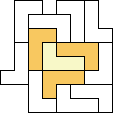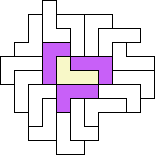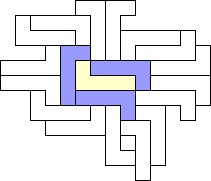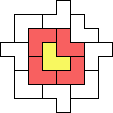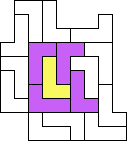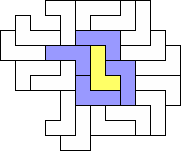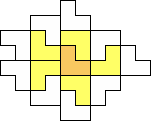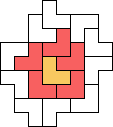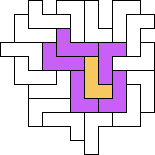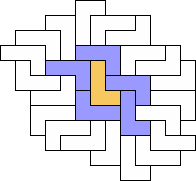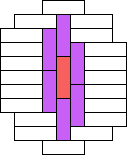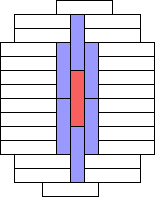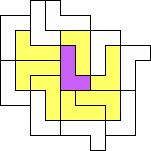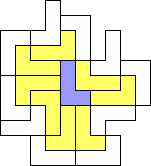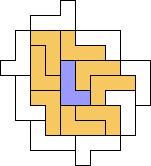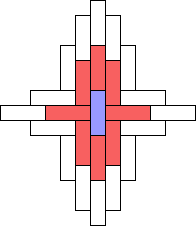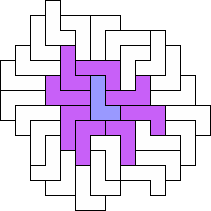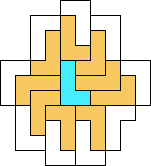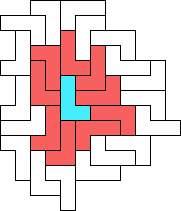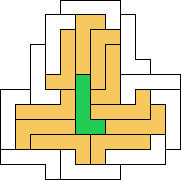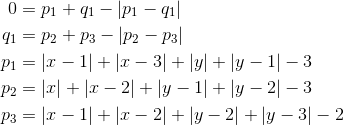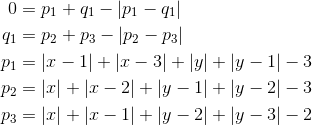Width 1
| Polyominoes | Coefficients | Sequence
|
|---|
 
| 1 1 | 1, 2, 3, 5, 8, 13, 21
|  
| 1 0 1 | 1, 1, 2, 3, 4, 6, 9
|  
| 0 1 1 | 0, 1, 1, 1, 2, 2, 3
|   
| 1 1 1 | 1, 2, 4, 7, 13, 24, 44
|  
| 1 0 0 1 | 1, 1, 1, 2, 3, 4, 5
|  
| 0 1 0 1 | 0, 1, 0, 2, 0, 3, 0
|   
| 1 1 0 1 | 1, 2, 3, 6, 10, 18, 31
|  
| 0 0 1 1 | 0, 0, 1, 1, 0, 1, 2
|   
| 1 0 1 1 | 1, 1, 2, 4, 6, 9, 15
|   
| 0 1 1 1 | 0, 1, 1, 2, 2, 4, 5
|    
| 1 1 1 1 | 1, 2, 4, 8, 15, 29, 56
|
|
Width 2
| Polyominoes | Coefficients | Sequence
|
|---|

| 1 1 | 1, 2, 3, 5, 8, 13, 21
|  
| 3 1 –1 | 2, 7, 22, 71, 228, 733, 2356
|  
| 1 1 3 1 –1 –1 | 1, 1, 4, 9, 16, 36, 81
|  
| 2 0 1 –2 1 –1 | 1, 2, 4, 7, 11, 26, 52
| 
| 0 0 2 | 0, 0, 2, 0, 0, 4, 0
|  
| 1 4 2 | 1, 5, 11, 33, 87, 241, 655
|  
| 2 0 1 | 1, 2, 5, 11, 24, 53, 117
|  
| 0 0 3 | 0, 0, 3, 0, 0, 9, 0
|  
| 1 1 | 1, 2, 3, 5, 8, 13, 21
|  
| 1 2 | 1, 3, 5, 11, 21, 43, 85
|  
| 0 1 1 | 0, 1, 1, 1, 2, 2, 3
|  
| 0 1 2 | 0, 1, 2, 1, 4, 5, 6
|  
| 1 1 0 3 1 –2 –2 –1 0 1 | 1, 1, 1, 4, 9, 16, 25
|  
| 1 2 –1 2 0 –1 | 1, 2, 3, 8, 14, 30, 55
|  
| 0 1 2 2 –1 –3 0 –1 –1 1 | 0, 0, 1, 1, 0, 1, 4
|  
| 0 0 2 2 0 0 0 –1 | 0, 0, 2, 1, 0, 4, 6
| 
| 0 0 0 2 | 0, 0, 0, 2, 0, 0, 0
|  
| 1 0 4 2 2 | 1, 1, 5, 11, 19, 43, 99
|  
| 1 1 4 2 | 1, 2, 7, 15, 32, 79, 185
|  
| 0 0 2 1 0 –1 | 0, 0, 1, 2, 0, 1, 6
|  
| 0 0 2 2 | 0, 0, 2, 2, 0, 4, 8
|  
| 1 1 1 | 1, 1, 3, 5, 9, 17, 31
|  
| 1 1 | 1, 2, 3, 5, 8, 13, 21
|  
| 0 0 1 | 0, 0, 1, 0, 0, 1, 0
|  
| 0 1 2 | 0, 0, 2, 0, 2, 4, 2
|
|




















































 (GS)
(GS) (GS)
(GS)



 (GS)
(GS) (GS)
(GS)



 (GS)
(GS)



 (GS)
(GS) (GS)
(GS)

 (GA)
(GA)
 (GS)
(GS) (GS)
(GS)

 (GS)
(GS)


 (GS)
(GS) (GS)
(GS)






 (GS)
(GS)


 (GA)
(GA)

 (GA)
(GA) 

 (GA)
(GA) 

 (GA) (GS)
(GA) (GS)


 (GA)
(GA)


 (GA)
(GA) 





 (GS)
(GS)






 (GS)
(GS)
 (GS)
(GS)
 (GS)
(GS)

 (GS)
(GS)

 (GS)
(GS)


 (GS)
(GS)


 (GS)
(GS)
 (GS)
(GS)


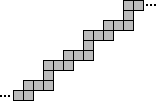 (GS)
(GS)


